UNUSUAL SPORTS IN CHINA
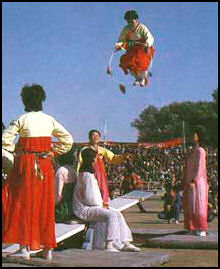
Korean seesaw Popular offbeat sports in China include dragon boat racing, cricket fighting and throwing ducks into a river and chasing them in painted boats. Many ethnic minorities have their own unusual sports.
Cock fighting and dog fighting are popular among gamblers. Camel-sleigh racing is performed for tourists in northern China. Bodybuilding contests are very big in southern China. There are races in some places in which men and women ride traditional Chinese style bikes with heavy bags of sand.
There are also praying mantis and spider fights. In the late 1990s cockroach fights we all the rage in Beijing. Particularly large and aggressive cockroaches from all over China were shipped to Beijing and winners made lots of money.
Horse racing is popular in Inner Mongolia and Tibet. Polo was played during the Tang Dynasty (A.D. 618-907) but was banned in the Mao era. It is now making a comeback thanks to Xia Yang, a 40-something property developer, who opened up the Sunnu Time Polo Club two hours outside Beijing with stables, 27 horses and trained coaches from Inner Mongolia.
SPORTS IN CHINA factsanddetails.com
Cricket Fighting in China
 Cricket fighting also has a long history in China. It dates back at least to the 14th century and has traditionally been a gambler's sport. The fights are often held in miniature arenas where determined punters fight for views, judges watch through magnifying glasses and most spectators watch on closed circuit television. [Source: Mia Turner, International Herald Tribune, June 19, 1999]
Cricket fighting also has a long history in China. It dates back at least to the 14th century and has traditionally been a gambler's sport. The fights are often held in miniature arenas where determined punters fight for views, judges watch through magnifying glasses and most spectators watch on closed circuit television. [Source: Mia Turner, International Herald Tribune, June 19, 1999]
The cricket fighting season begins in September when the crickets are about a month old. Bets frequently top $1,000 and sometimes exceed $10,000. Because the stakes are so high and gambling is technically illegal, many of the fights are held in private homes or discreet corners of parks. Chinese are particularly fond of crickets because they are said to bring good luck and wealth.
Cricket fights take place in eight-inch-wide plastic containers. The owners of the crickets poke the insects with little hairs attached to a chopstick-like devise or some other instrument. During the fights crickets butt heads, toss each other out of the ring, with the winner chirping lodly as the loser slinks away.
Describing a fight, Mia Turner wrote in International Herald Tribune, "Once in the ring the competitors are then tickled with a rabbit-hair brush or a stick of grass to incite them. In the most vicious matches, which last about five minutes, the crickets, who fight with their jaws, can tear the claws off their opponents...A fighter who runs away automatically loses."
The annual Chinese national cricket-fighting tournament is held in Beijing. Held on the grounds of a large temple, the matches are video taped and shown live on big screens so observers can get a good look at the action. The crickets have names like Red General and Purple Tooth King. In Macau, crickets are matched according to their size. Before a fight the are stirred up by brushing a mouse whisker on their antennae.
Chinese Fighting Crickets

cricket tease There are several different kinds of crickets. Most of them have wings but can not fly and produce their song by scraping their wing covers together. Male crickets like to fight. They are also the ones that produce the songs.
Fighting crickets are about two inches long. The largest ones weigh about half a gram. Before a bout they are weighed in like boxers and matched against crickets of around the same weight. When they are not working the crickets often sing. They like to sing when they are warm, producing a noise like a working loom, which is one reason they are called "cushi" (literally "call to work at the loom") in Chinese.
The strongest and fiercest crickets are said to come from Shandong province in northeast China. Wild ones are said to be best. Attempts at breeding have only resulted in weak fighters. There are several lively cricket markets in Shandong. The ones in Ningyang are particularly famous. Here it not uncommon for people to spend over $10,000 for a single cricket. In Shanghai fighting crickets and pet crickets go for between $1.45 and $14.50 with exceptional creatures fetching $1,000.
Fighting crickets fight only one time because anything more than that, one dealer said "would exhaust them." Winners live out the rest of their lives in pampered luxury inside elaborately adorned cages and porcelain jars in the summer, and hollowed-out, molded gourds in the winter. Sometimes gourds are inlaid with silver and ivory, insulated with pea paste and cabbage leafs and washed every day with tea. In the old days crickets were kept in silk purses.
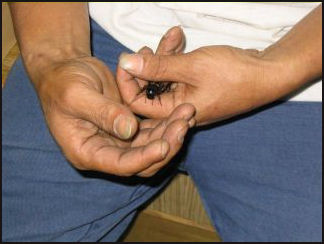
Criceket warm up Fighting crickets are fed powdered tofu and calcium supplements and prodded with straws during training sessions. Good fighters also tend to be good in bed and are encouraged to make love to three or four females before a fight. One dealer told the International Herald Tribune, "These days the crickets are treated like Olympic athletes. They give them drugs to perform better. In the old days we enjoyed them as a hobby. But today they don't care about them dying. They lost the spirit of the competition."
The cricket trade is so lucrative that farmers have let their fields become fallow so they can be used as cricket breeding grounds. In some places cricket-fighting mania has gotten out of hand, "There getting crazy," one dealer told the International Herald Tribune. "They’re battering an ox for a small cricket.”
Cricket Singing Contests in China
In recent years cricket singing contests have become popular in Beijing. Describing one event Barbara Demick wrote in the Los Angeles Times, “The performers are lined up in glass bottles that look like big salt shakers. Some have socks around them to keep out the late December chill, because its well known that cold crickets don’t sing. Hovering over the bottles, a judge wields a hand-held sound meter.”
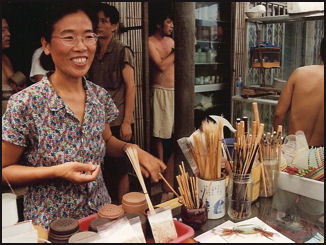
Cricket seller Loudness is often the main criteria but timbre and resonance are also taken into consideration. Winners have recorded sounds of 106.3 decibels, louder than a lawn mower. Most of the cricket owners and observers are men, some with cell phones that chirp and jackets with pockets for their gourd-shaped cricket carriers. Some cheat by giving their crickets drugs which slows the rate of vibrations and produces a deep, more resonant sound.
Cricket fancying has a long history in China. Tang princes were often obsessed with crickets and instruments played in Peking Opera were reportedly inspired by them. The Last Emperor Pu Yi kept a cricket as a pet. The Communists found the custom to be decadent and distasteful and banned it.
Most singing crickets are bush crickets or katydids’species that are bigger and lighter than fighting crickets. Top of the line ones sell for as much as $250 a piece. Coddled ones live in decorated gourds, costing hundreds of dollars, that have their own water and food bowls and canopied beds and are fed specially-prepared mixtures of tofu, chopped vegetables and worms.
Molded gourds have traditionally been made for singing insects such as crickets. They were built to resonate and their shape varied in accordance with the type and size of the insect they housed. The gourds are molded on the vine in carved wooden molds, hollowed, dyed and lined, for acoustic reasons, with mud composed of limestone, yellow earth and sand.
Recreating the Ancient Song of a Jurassic-era Chinese Cricket
In February 2012, AFP reported: “The call of a Jurassic-era cricket was simple, pure and capable of traveling long distances in the night, said scientists who reconstructed the creature's love song from a 165 million year old fossil. British scientists based their work out on an extremely well preserved fossil of a katydid, or bush cricket, from China named Archaboilus musicus. The cricket lived in an era when dinosaurs roamed the earth. [Source: AFP, February 7, 2012]
The detailed wings, measuring about 72cm (three-quarters of an inch) long, allowed scientists to recreate for the first time the features that would have produced sound when rubbed together. The result is 'possibly the most ancient known musical song documented to date,' said the study which appears in the US journal the Proceedings of the National Academy of Sciences.
The ancient katydid's call should be imagined against a busy backdrop of waterfalls, wind, the sound of water coursing through streams and other amphibians and insects serenading would-be mates, the study authors said. 'This Jurassic bush cricket... helps us learn a little more about the ambiance of a world long gone,' said co-author Fernando Montealegre-Zapata of the University of Bristol.
Songbird Competitions in China
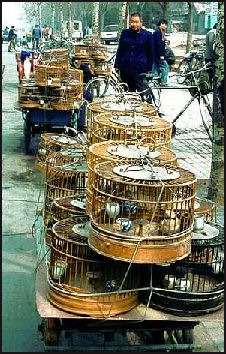
Song brid market
Bird singing contests are often held on Sunday mornings, with the winners being the birds that can sing the highest number of different songs in 15 minutes. The country of Suriname is said to have the best singing birds. The bird are usually Twa-twas or Picolets and the record is 189 different songs by a bird named Flinto owned by Jong Kiem. Kiem told Reuter" "The best birds do what you want them to do...Sometimes the bird doesn't want to sing so you have to check where the problem is. You have to be very patient."
Song birds are kept in bamboo cages. It is very common to see Chinese with cloth-covered cages in parks taking their birds for "walks." Travel writer Paul Money once remarked that "China is probably the only place where people walk their birds and eat their dogs." Younger birds are trained by carefully placing them near older birds.
The Chinese enjoy bird singing competitions. Some of them pay large sums of money for rare birds and keep them in tiny ornate cages. The best birds cost as much as $2,000 and are kept in teak cages. Among the birds favored for their songs are tiny Japanese white-eyes and hwamei. Newly caught birds sell for as little a $1.50 but ones who have been trained for a year fetch as much as $300. The white-eyes tend to be kept in nice, elegant cages while the hwamei are kept in more spartan solid-sided cages.
Keeping song birds has long been a favorite hobby of the rich and powerful in China. Hans Christian Anderson’s fairy tale The Nightingale is about an Emperor obsessed with the song of a nightingale. Keeping song birds was frowned upon in teh Mao era and viewed as crime in the Cultural Revolution.
It is not unusual to see old men riding around with bird cages attached too their bicycles. Among the singing birds found in city bird markets are rose finches, plovers, Oriental magpie robins and Mongolian larks.In a typical Chinese bird market you can recently caught thrushes, skylarks and grosbeaks, looking ragged in their cruelly-small cages. Sometimes sparrows are kept on leashes by children who tame the birds by quietly stroking their heads. Budgies and minias are often raised in captivity. Exotic birds like fallvettas, leaf birds and yhina and caught in the south and transported to the north,
Bullfighting in China
In the early 2000s, there was a plan to introduce bullfighting with Spanish matadors and Mexican bulls to China. Headlines in Chinese newspaper read: “Foreign Bulls Head for the Middle Kingdom;” “Local Promoters Salivate Over the Prospects of Bloodthirsty Crowds.”
A 6,400-seat bullfighting ring was built at the Beijing Wildlife Park outside of Beijing to host the spectacles. Promoted mainly as a way to generate tourist money, the plan was for the Spanish matadors to teach local Chinese their skills and for the Mexican bulls to be replaced by local ones once fierce enough ones could be bred.
In the end bullfights never took place. They were done in by a fledgling animal rights movement, which pressured lawmakers and bureaucrats, organized protests and letter writing campaigns and was joined by environmental groups from all over the country.
The wildlife park tried to rally local government and business leaders to support it but in the end withdrew the plan and refit the stadium so that it could host American-style rodeos instead. Some Chinese were sorry. A 27-year-old policeman told the Los Angeles Times, “I liked bullfights when I saw them on TV. Young people like thrilling things. I’m a bit sorry it was canceled.” A worker at the bullring said, “I wonder if they planned to serve meat from the bulls they killed in here.”

Dragon Boat Racing in China
Dragon boat racing is a very old sport. It is practiced in China and other places where Chinese are found and is particularly popular in Hong Kong, where the dragon boat festival is a public holiday. In recent years the races have become quite popular in the United States, where there are over 400 teams.
Dragon boat races are run over 250, 500 and 1,000 meter courses to the rhythm of drums beaten loudly on the boats. Describing a 250-meter dragon-boat race, Sandee Brawarsky wrote in the New York Times, "The race doesn't take much more than a minute. In a long, narrow boat...18 paddlers, seated two by two, dig their wooden paddles into the murky waters...Forcefully they pull back...They aim to move in perfect sync, propelling the boat across the finish line like an arrow."
Usually four boats race at a time. Depending on how many boats are participating there are heats, semifinals and a final. Describing the appeal of the sport one man told Inside Business, “It has a visceral feel that appeals to everyone. The beat of the drums, the spray of the water from the crashing bow of the bow, and 20 people working as one to breath life into the dragon.”
See Dragon Boat Festival, Festivals, Hong Kong
History of Dragon Boat Racing

Dragon boat races honor the patriotic poet Qu Yuan, the first of China's great poets. Qu, a minister in the Chinese kingdom of Chu, was popular with the people but was banished from his home land by a king who didn't like him. For years he wandered the countryside, writing poetry and expressing his love for the country he missed.
Qu committed suicide in 278 B.C. by who drowning himself in the Milou River after hearing that Chu had been invaded and conquered. The dragon boat races symbolize the desire to bring Qu Yuan back to life. According to legend, local fishermen raced out to try save him and whipped their paddle in the water and beat drums so that the fish would not devour his body. The races are also tied to dragons which the Chinese believe originate in the water and bring good luck.
To honor Qu Tuan's death during the Dragon Boat Festival “zongzi” (traditional glutinous rice cakes wrapped in bamboo leaves) are wrapped in colorful silk and thrown into the water as an offering to the poet's spirit. The silk is used to keep away the flood dragon, who is afraid of silk. The festival tries to appease the god of the streams — the Dragon’so that rivers will not overflow their banks and cause floods.
Dragon Boats and Dragon Boat Teams
Dragon boats are 35 feet long and weigh about 2,000 pounds each and cost between $3,000 and $14,000. Most are made by hand from teak in Hong Kong and modeled after centuries-old fishing boats. On the bow is a dragon head; on the stern is a tail, both of which are colorful and elaborately carved. The boats are often painted the day before a race, sometimes with dragon scales.
A typical dragon boat team consists of 20 members: 18 paddlers, one member, who seating at the bow pounds out a rhythm on a drum so the paddlers can stay in sync, and another one member who sits at the back and steer with a rudder. Big boats may have as many a 100 paddlers.
Dragon boat races are usually held during the dragon boat festival that opens with a parade of teams and dragon dancers. During the race flags are waved with great excitement and gongs and drums are banged making a big ruckus.
Dragon Boat Racing Strategy
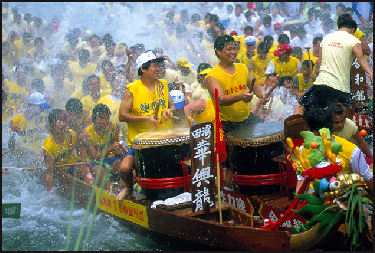
Timing and staying synchronized are keys to dragon boat racing success. One paddler told the New York Times, "During the race, you're all beating as one heart. You need to mirror the stroke of the person diagonally in front of you. And you need to trust the people in front are going to be in sync with the people in front of them. Competition keeps your spirit going."
Different teams have different paddling styles. Some hit the water aggressively. Other raise their paddles out of the water with a twist. Others still are encouraged to breath in unison and to pull and relax as they stroke.
Ideally the best paddlers are in the front and they keep a unified rhythm the others can follow. The paddlers in the middle are the strongest and have the longest strokes. Those in the back are the most aggressive.
Another paddler told the New York Times, "It's a sprint race for the most part. The whole thing revolves around getting a good start so you can pull ahead early on and keep a psychological edge."
Dragon Boat Racing Outside China
Dragon boat races are held in the United States, Australia and other places. Among the teams in the Californian Dragon Boat Association are the Wal-Mart Warriors, VeRizing Dragons, Kaiser Permanente Dragon Healers and Starbucks Waverunners. There are also school, police and firemen teams. Some use specially-designed $20,000 carbon fiber boats and $200 carbon fiber paddles (conventional wooden ones cost around $30).
In the United States there are 75 dragon boat festivals in 31 states and 70 cities. Large events attract 100 teams that typically pay a $2,500 entrance fee. Usually the boats compete in heats with four or five boats and follow lanes marked in the water. Some events in the United States attract 50,000 spectators.
Image Sources: 1) University of Washington; 2, 3, 4) Taiwan School; 5) Julie Chao; 6) Beifan; 7,8) Midwest Dragonboat Racing; 9) Hong Kong Tourism
Text Sources: New York Times, Washington Post, Los Angeles Times, Times of London, National Geographic, The New Yorker, Time, Newsweek, Reuters, AP, Lonely Planet Guides, Compton’s Encyclopedia and various books and other publications.
Last updated April 2012
